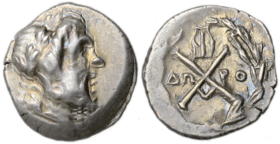Homarium

The Homarium was the common temple of the Achaean League, built c. 371 BC at Aegium. While it was dedicated to Zeus Homarius or Homergyrius (the exact meaning of the name being uncertain, but probably "who unites"), the temple was, according to Polybius, used for meetings and debates on Achaean lines.[1] Strabo describes it as a grove, near a temple of Demeter Panchaea.
Again, according to Polybius [5:93] resolutions to internal Achaean disputes during the Social War were recorded on a stele erected near the altar of Hestia or Vesta.
Pope, in his 1715 Essay introducing his translation of Homer's Iliad, refers a temple erected to Homer as "the true Homærium", and comments on dispute over its locality. By 1872 this was described as a back-formation.
The Acahean colonies in Italy, Sybaris, Caulon and Crotona similarly established a Homarium as a common forum.
Zeus Homarius
Nineteen states of the Achaean League minted triobols (or hemidrachms), small silver coins worth three obols, carrying a bust of Zeus Homarius on the obverse.[2] Later bronze coins were minted by the members of the league, also bearing the image of Zeus Homarius, holding a miniature Nike, presenting him a wreath. The later bronze mintage is remarkable for the number of towns and villages that produced coins, some forty five, and the number of die used, estimated at 1600.[2]
Achaean oath
The Achaean oath was taken upon the trinity of Hamarium Zeus, Hamarium Athena and Aphrodite.